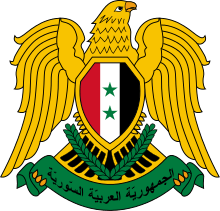Denmark–Syria relations
 |
|
Denmark |
Syria |
|---|---|
Denmark–Syria relations are foreign relations between Denmark and Syria. Both countries established diplomatic relations on August 29, 1992. Denmark is represented in Syria through its embassy in Damascus. Following the Jyllands-Posten Muhammad cartoons controversy and subsequent attack on the Danish embassy in 2006, relations between the two countries were greatly strained.
Reaction to Jyllands-Posten Muhammad cartoons and violence against Danish Embassy
Following the publication of the Jyllands-Posten Muhammad cartoons, relations between the two countries were greatly strained. On 4 February 2006, the Danish and Norwegian Embassies in Damascus were torched by protestors.[1][2][3][4] They waved portraits of Syrian President Bashar al-Assad, leather-bound copies of the Quran, and the flags of Hamas and the Lebanese militant group Hezbollah. [5] Hundreds of protesters hurled stones at the Danish embassy before scaling it, amid chants of "God is great" before moving on to attack the Norwegian embassy.[4][6] A bomb threat was also made against the Danish embassy although no bomb was found.[7]
Danish Government response
Danish Prime Minister Anders Fogh Rasmussen said that the governments of Iran and Syria had intentionally inflamed Muslim protests against a Danish newspaper's publication of cartoons depicting Muhammad to distract attention from their own diplomatic crises. He said "Syria and Iran have taken advantage of the situation because both countries are under international pressure," Rasmussen also said he would "not exclude the possibility" that Syria had also been involved in violent protests in Beirut, Lebanon [8] referring to the fact that similar violence against the Danish Embassy in Beirut occurred the following day after the attacks in Damascus.[5]
Foreign Minister Per Stig Moeller said that "Syria failed in its duty. It is completely unacceptable that the embassy was not protected by the Syrians".[1] Stig Moeller said his government had also asked the European Union to condemn events in Damascus. Shortly after the attack, the Danish government told its nationals to leave Syria immediately.[1] Danish diplomatic staff also left Syria and temporarily closed its embassy stating that staff "have provisionally left Syria because Syrian authorities reduced their protection to an unacceptably low level".[6]
Syrian response
A day after the attacks, Syria's foreign ministry issued a statement expressing "its regret over the acts of violence which accompanied the protests." [6] The Syrian Government denied any role in the attacks [5] and blamed Denmark for the violence and an editorial in Syria's state-run daily newspaper said that "Denmark's government could have avoided reaching this point simply by issuing a sincere apology".[2][5] Syrian Foreign Ministry condemned the cartoons as an offence to Muslims and Arabs and demanded the Danish government punish the offending paper.[7]
Syria recalled its ambassador from Denmark.[7][9] Danish goods including Lego and Bang & Olufsen were boycotted in Syria.[3]
Response from others
The governments of the United States and Norway placed the blame for the rioting squarely on the Syrian government for failing to protect the embassies.[2] The US Government said it was "inexcusable" for such damage to be inflicted on diplomatic missions.[6] US President George W Bush condemned the violence against Danish embassies and spoke about this incident in a phone call to the Danish Prime Minister.[8] Bush also said "I call upon the governments around the world to stop the violence, to be respectful, to protect property, protect the lives of innocent diplomats who are serving their countries overseas."[10] Scott McClellan, the White House Press Secretary said “We hold Syria responsible for such violent demonstrations since they do not take place in that country without government knowledge and support,”
Ensuing relations
On the 27 February, Denmark's ambassador to Syria, Ole Egberg Mikkelsen, returned to Damascus, where he had a meeting with the Syrian Deputy Foreign Minister, Ahmad Arnous [11] They discussed how to enhance bilateral relations through dialogue and mutual understanding and Minister Arnous stressed Syria's keenness to continue relations with Denmark. The Syrian Government said it would compensate for the damages made in these incidents to embassies.[12] However, by February 2007, it was reported Denmark had received no compensation from the Syrian Government for the damage.[13]
In January 2007, Danish embassy staff including the ambassador evacuated the country following security concerns.[14]
Cultural relations
The Danish government has also a Danish Institute based in Bayt al-Aqqad in Damascus which opened in 2000.[15]
See also
- Foreign relations of Denmark
- Foreign relations of Syria
- International reactions to the Jyllands-Posten Muhammad cartoons controversy
References
- 1 2 3
- 1 2 3 Archived February 18, 2011, at the Wayback Machine.
- 1 2 Rosalind Ryan (12 February 2008). "How the Muhammad cartoons row escalated". The Guardian. Retrieved 20 August 2013.
- 1 2 Two embassies in Syria torched over cartoons CTV 4 February 2006
- 1 2 3 4 "Topic Galleries". Baltimore Sun. Retrieved 20 August 2013.
- 1 2 3 4 KBC
- 1 2 3 Syria recalls ambassador from Denmark over cartoons Reuters via Star Online 1 February 2006
- 1 2 "Danish Premier Faults Iran, Syria". The Washington Post. 10 February 2006. Retrieved 20 August 2013.
- ↑ "Syria recalls ambassador to Denmark over disputed cartoons". Xinhuanet. 1 February 2006. Retrieved 20 August 2013.
- ↑ Runningen, Roger (8 February 2006). "Bush Calls for Halt to Violent Protests over Cartoon". Bloomberg. Retrieved 20 August 2013.
- ↑ Syria "wants a good relationship with Denmark" Danmarks Radio, Copenhagen - 27 February 2006
- ↑ "Syria, Denmark discuss means to enhance ties". Xinhuanet. 28 February 2006. Retrieved 20 August 2013.
- ↑ "Syria Pays Norway for Embassy Damage". Aina. 27 February 2007. Retrieved 20 August 2013.
- ↑ The Embassy Staff Leaves Syria Temporarily Ministry of Foreign Affairs of Denmark 8 January 2007
- ↑ Danish Institute Archived February 7, 2009, at the Wayback Machine.

